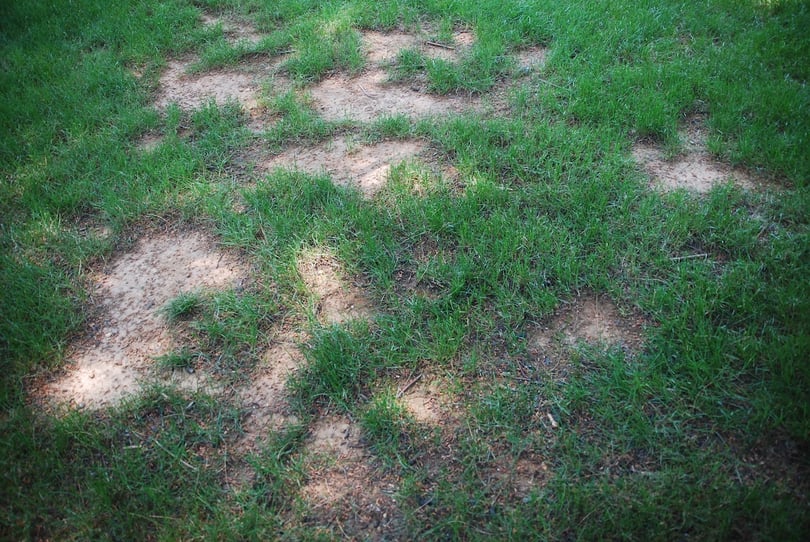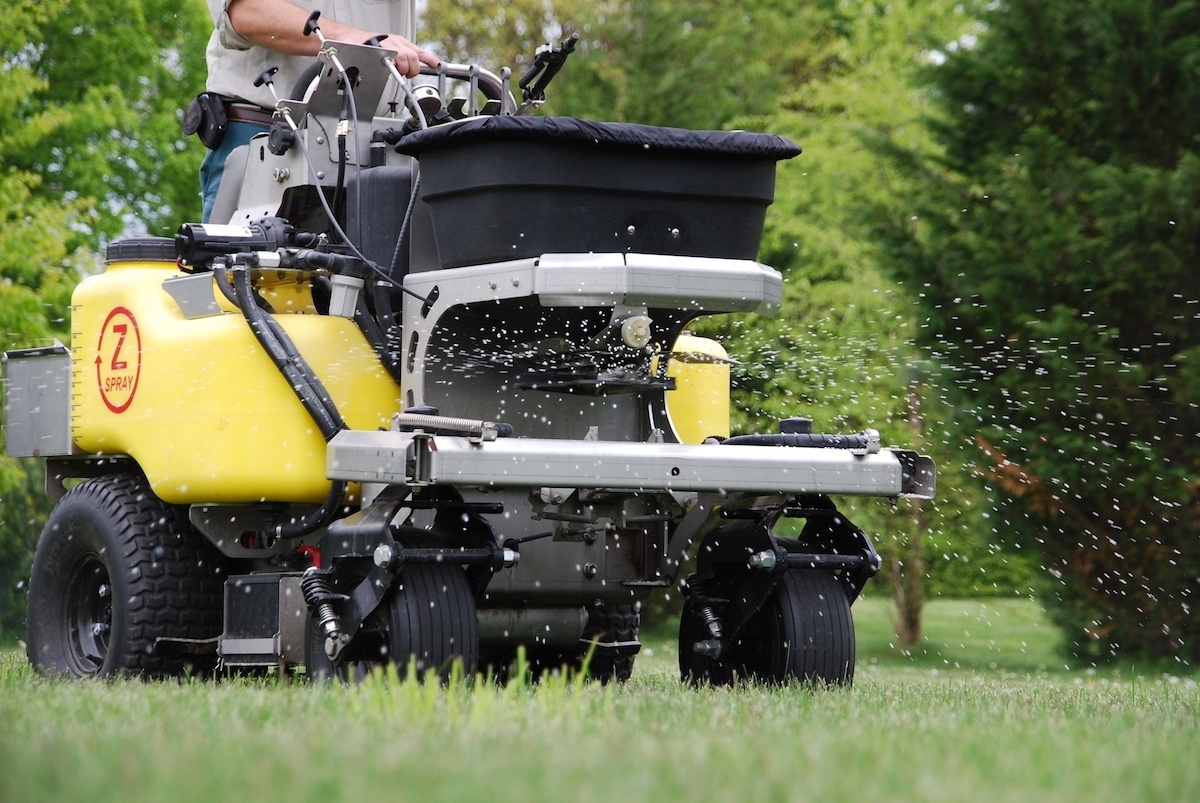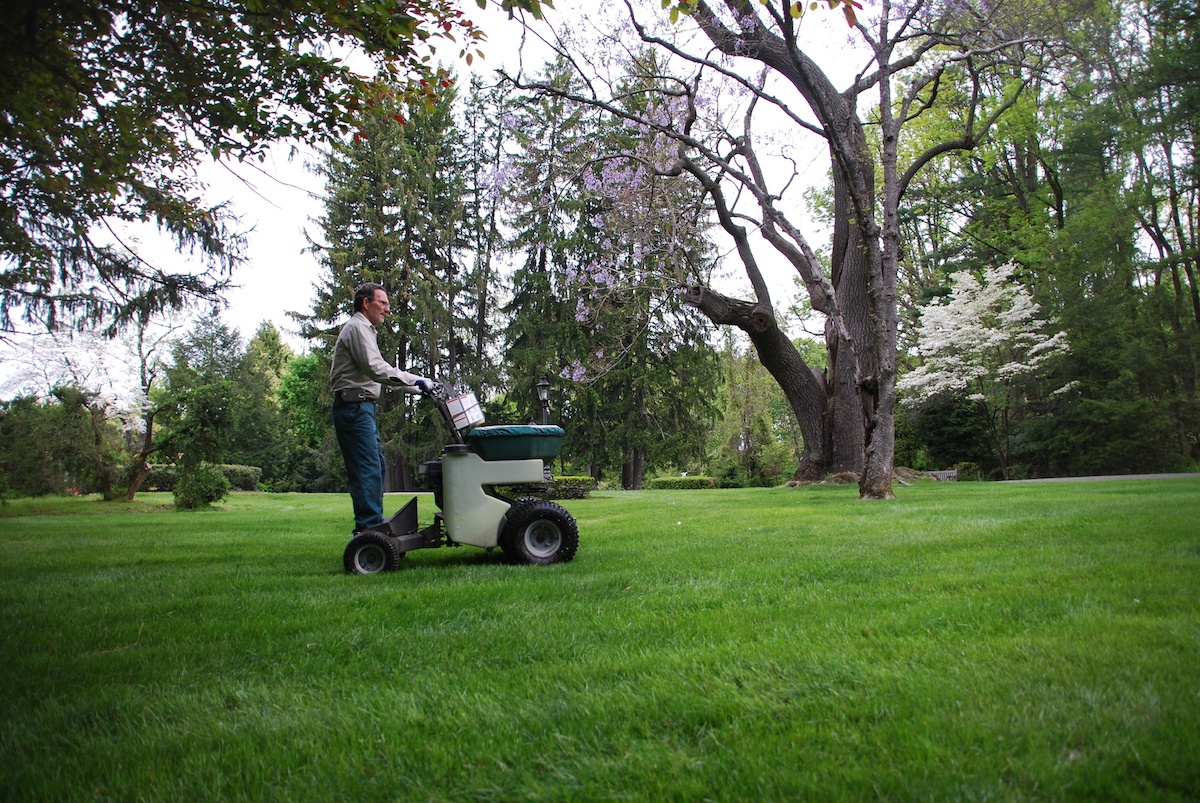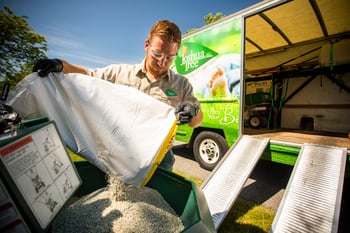We find that there are often a lot of misconceptions about lawn fertilizing that have our clients (and potential clients) confused. Understanding lawn fertilization can be challenging with so much misinformation circulating. Since we often hear a lot of lawn fertilizer myths, we wanted to help set the record straight. Here are 11 myths, debunked, along with the correct information that you can trust.
1. Fertilizer is Plant Food
You may have heard, or even come to believe, that fertilizer is “plant food.” Plants create their own food through the process of photosynthesis. The trouble with this lawn fertilizer myth is that when people believe their fertilizer is food, they assume that if their lawn is not healthy that it must not be eating enough. That can lead to further misconceptions including the unnecessary addition of more fertilizer when that’s not what’s really needed. Fertilizer will assist lawns in natural processes that lead to better health, but it’s not food.
2. Lawn Fertilizing is Unnecessary
While misconceptions may lead some to over-fertilize, on the flipside of the lawn fertilizer myths is the idea that your lawn doesn’t actually need it. While your lawn may survive without fertilizer, it certainly isn’t going to look its best. That’s because most soil does not provide the essential nutrients that your lawn truly needs to thrive. Over time, the nutrients will deplete and you could already have soil that is deficient in some important elements. If you care about a lush, green lawn, then you should absolutely be fertilizing.
3. Fertilizer Can Fill in Bare Spots
If you have a bare spot the size of a baseball or smaller, fertilizer may provide enough coverage to make it unnoticeable.

Grasses grow in two main ways. Some species are clumps and some knit together. Under ideal conditions, clumps can enlarge and knitting may happen, but there is only so much fertilizer can do to aid in this, particularly in a short time frame under even the best environmental conditions.
If you have hundreds or thousands of baseball-sized spots or any one spot that is larger, fertilizer simply isn’t going to be an effective fix. You really need to have lawn seeding services in order to fill in those bare spots.
4. All Fertilizers are Created Equal
All lawn care programs are not the same and that’s often because of the differences in products being used. Just like anything else in life, there are many different products to choose from at a very wide range in cost. Some products that cost more, also perform better.
If you’re comparing two different lawn care programs and one costs more, they may be using better products. At Joshua Tree, we also use biostimulant additives with our lawn fertilizing program. Biostimulants are organic materials, that when applied in small quantities, enhance plant growth and development. This is an added benefit that gives you extra value out of your investment in a healthy, green lawn.
5. The More Fertilizer, the Better
We find that a lot of homeowners believe the more fertilizer added to their lawn, the better. The truth is, most summer lawn diseases are actually aggravated by too much quick release nitrogen fertilizer. If you’ve unknowingly hired a lawn care company that uses quick release nitrogen fertilizer (or maybe do one as a late summer treatment), and your lawn is struggling with turf disease, it could make it a lot worse. An educated lawn care technician will know this.

In addition, over-fertilizing grass in shady areas is a big problem. The type of desirable grasses that grow in these areas will get stressed from too much lawn fertilizer and thin out or die.
6. I Should Not Mow After a Fertilizer Treatment
We get a lot of questions about mowing after fertilization. While a lot of homeowners believe that if they mow, they will pick up granules, the truth is there is not enough suction to pick up a significant amount of fertilizer with your mower. Even if you have a bagger on your mower, you don’t need to hold off from mowing after a granular lawn fertilization.
7. Organic Lawn Fertilizer is Better than Synthetic
Many people are conditioned to believe the word “organic” automatically equates to better, but this isn’t necessarily true with fertilizers. With fertilization, the plant uses the nitrogen from the product by converting it . While synthetic can be converted more quickly, that’s not necessarily a bad thing.
Organic fertilizer tends to break down slower and that’s not necessarily bad either. It all depends on the program and what your lawn care company is doing. A good lawn care company will know what product is best for your needs and may even use a combination of both types of fertilizer.
8. If My Lawn isn’t Green, I Need More Fertilizer
If your lawn isn’t green, it’s not necessarily fertilizer-related. There are many reasons that your lawn may not be as green as you wish. Soil pH is a big one. When lawns start to yellow, it’s often because the soil pH is too low.
But there are other factors, such as disease, insects, or drought, which could also be the issue. Or, it could even be related to your grass species. If your neighbor’s lawn looks like a different shade of green than yours, they may have more of a different species growing. Some grass species are darker shades of green than others.
9. The Higher the Numbers on the Bag, the Better
It’s a common lawn fertilizer myth that fertilizers with higher numbers in the analysis are better. For instance, a bag with the numbers 36-10-5 is better than a 21-3-10. Some homeowners know that nitrogen is what makes their lawn green and they automatically assume that first higher numbers is better. But that ratio just represents the percentage of Nitrogen-Phosphorous-Potassium and what really matters is the application rate. That’s a complex issue that lawn care companies figure out. Don’t just assume that a higher number means an automatically greener lawn. Unfortunately, it’s not that simple.
10. I Only Need “X” Applications a Year
Fill in X with whatever number you wish—we’ve heard all the lawn fertilizer myths when it comes to the number of applications needed in a year. But the truth is, it’s all relative. You could deliver a lot of nutrients in three visits a year or you could slowly fertilize a lawn over five or six visits a year.

People get very caught up on a specific number of visits but what really matters is the rate of application and the products being used. Some lawn fertilization companies like to make a big deal about the number of visits they perform. What you really need to ask yourself is whether you trust your lawn care company to put down what your lawn needs throughout the year. That’s all that really matters.
11. All Lawn Fertilization Companies Do the Job the Same
We already talked about the fact that there are many different products on the market and different companies invest more in product than others. But there are other differences between lawn fertilization companies as well. From thoroughness of application to cleaning up walks and driveways after their treatments to being careful in avoiding pools or fish ponds—these are just some of the ways in which one company may excel over another.
Some companies also highly incentivize the quantity of production completed each day. This could cause technicians to rush through each job, trying to get as much done in a day as they can. But at Joshua Tree, we pay the same hourly rate, no matter how much work gets done in a day. We want our technicians to focus on doing the best job possible—not on how many lawns they can get done in order to get paid more. It’s important to be productive, but the client comes first.
Myth Busting at Joshua Tree
 Whether it’s lawn fertilizer myths, or something else, we know there is a lot of misinformation out there about lawn care. Unfortunately, some lawn care companies perpetuate those myths by failing to educate their clients.
Whether it’s lawn fertilizer myths, or something else, we know there is a lot of misinformation out there about lawn care. Unfortunately, some lawn care companies perpetuate those myths by failing to educate their clients.
But at Joshua Tree, we’re all about helping homeowners separate the fact from the fiction at any level of detail that you desire. We’ll get as technical as you want if you’d like to truly understand how these processes work.
At the end of the day, our goal is to be a trusted resource for all things related to your lawn so that you don’t have to search for answers online or wonder what information to trust. If you have questions about lawn fertilizing, or any other lawn care issues, we’re here to help.
With the right care for your lawn, you’ll gain valuable peace of mind. If you’re interested in having your lawn inspected and its health assured, contact us for a free quote or give us a call at 833-JTE-TREE.



